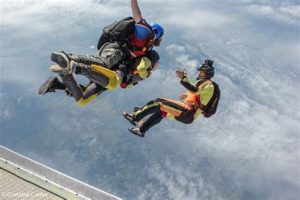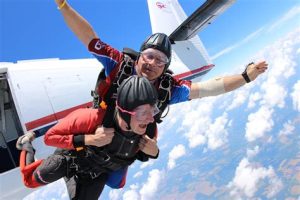Table of Contents
Discover the wind limits for tandem skydiving and ensure a safe and thrilling experience. Understand the importance of wind speed and direction in determining if it is optimal for tandem jumps. Find out how wind limits are set and the potential risks associated with exceeding them. Take the leap and enjoy the adrenaline rush of tandem skydiving within the recommended wind limits.
Are you ready to take the plunge and experience the exhilarating thrill of tandem skydiving? Before you do, it’s important to familiarize yourself with one crucial aspect that ensures your safety and a successful jump: wind limits. Whether you are a first-time skydiver or an experienced adrenaline junkie, understanding the significance of wind limits is paramount. In this guide, we will delve into the importance of wind limits for tandem skydiving, explore the factors that determine these limits, and provide essential information on how they are measured. So, buckle up and get ready to learn about the crucial role wind plays in making your tandem skydiving adventure both safe and unforgettable!
Introduction
When it comes to tandem skydiving, safety is of utmost importance. One crucial factor that can greatly affect the safety of a jump is the wind conditions. Wind limits for tandem skydiving are set to ensure the well-being of both the passenger and the instructor. In this article, we will explore the importance of wind limits, how they are determined, and what happens when wind speeds exceed the set limits.
Understanding Wind Speed
Before delving into wind limits, it’s essential to have a basic understanding of wind speed. Wind speed refers to the velocity at which the air is moving horizontally. It is typically measured in miles per hour (mph) or knots. The wind speed at various altitudes can vary, so it’s essential to consider the conditions both on the ground and at the jump altitude.
Factors Influencing Wind Limits
Several factors come into play when determining wind limits for tandem skydiving. These include the experience level of the instructors, the size and weight of the passengers, the type of parachute system being used, and local weather patterns. Each drop zone may have slightly different wind limits based on these factors.
The Importance of Wind Limits
Wind limits are crucial for ensuring the safety of skydivers. Excessive wind speeds can make it challenging to maintain stability during freefall, increasing the risk of accidents. Additionally, strong winds can make it difficult to control the parachute during descent, potentially leading to a rough landing or loss of control.
Typical Wind Limits
The specific wind limits for tandem skydiving can vary from drop zone to drop zone. However, as a general guideline, most drop zones set the limit at around 20 mph or 17 knots for tandem jumps. This is considered a safe range that allows for stable freefall and controlled parachute descent.
Wind Limits for Students
For student skydivers, including those undergoing tandem jumps, wind limits are usually more conservative. This is because students have less experience and may require additional assistance from instructors during the jump. Typically, wind speeds of around 14-18 mph or 12-16 knots are considered safe for student skydiving.
Monitoring Wind Conditions
Prior to each jump, drop zone staff closely monitor the wind conditions at various altitudes. They use anemometers, which are devices that measure wind speed, to assess the current conditions. Additionally, they consider weather forecasts and observations from experienced instructors who may have already made jumps that day.
What Happens When Wind Speed Exceeds Limits?
If the wind speed exceeds the set limits, tandem skydiving operations are generally put on hold. The drop zone may temporarily suspend jumps until the wind conditions improve and fall within the safe range. This is done to mitigate any potential risks and ensure the safety of all skydivers.
Flexibility in Wind Limits
While wind limits are crucial for safety, there is some flexibility in certain situations. Highly experienced instructors may be permitted to conduct jumps in slightly higher wind speeds, provided they have the necessary skills and expertise. However, this flexibility is always within a reasonable range to maintain safety standards.
Conclusion
Wind limits for tandem skydiving play a vital role in ensuring the safety of both instructors and passengers. These limits are determined based on various factors and are closely monitored before each jump. By adhering to wind limits, skydiving operations can be conducted in a controlled and safe manner, allowing everyone to enjoy the thrilling experience of tandem skydiving.
Wind Limits for Tandem Skydiving: Usage Instructions
Subtitle 1: Understanding Wind Conditions
1. Wind Speeds: Before participating in a tandem skydiving experience, it is crucial to understand the acceptable wind limits. Pay attention to the safety considerations imposed by tandem skydiving operations regarding wind speeds.
2. Verify Local Wind Conditions: To ensure that the wind speeds are within acceptable limits for tandem skydiving, check weather reports or consult with the designated skydiving center. It is important to be aware of the current wind conditions before starting your skydiving adventure.
3. Safety Precautions: Tandem jumps are typically conducted when wind conditions are optimal for a safe and enjoyable experience. Always follow any specific safety instructions provided by the skydiving center regarding wind limitations. Your safety should always be a top priority.
Subtitle 2: Maximum Headwind Restrictions
1. Maximum Headwind Limit: Tandem skydiving operations usually have specific headwind limits, which refer to the speed and direction of the wind directly against the forward movement. Adhere to these headwind restrictions defined by the skydiving center to maintain stability during freefall and canopy deployment.
2. Safety Procedures: Headwind limitations are crucial for a safe landing. Respect the recommendations provided by the skydiving staff to ensure a smooth and controlled descent. Following these procedures will minimize any potential risks associated with headwind conditions.
3. Consult Experienced Instructors: If you are unsure about the current headwind conditions, seek guidance from experienced skydiving instructors. Their knowledge and expertise will help assess if the wind conditions meet the acceptable limits and ensure your safety throughout the tandem skydiving experience.
Subtitle 3: Side and Crosswind Considerations
1. Sidewind Restrictions: Tandem skydiving centers may impose restrictions on the presence of sidewinds during skydiving operations. It is important to understand and maintain the recommended limits for sidewind speeds to guarantee safe canopy control.
2. Safety Precautions: Sidewinds or crosswinds can affect the accuracy of your landing and pose potential risks. Communicate with the skydiving professionals to determine the safest actions to take under such conditions. Their expertise will guide you in making informed decisions about tandem skydiving in challenging wind conditions.
3. Trust the Experts: Rely on the expertise of your skydiving instructors to assess sidewind velocities and make informed decisions about tandem skydiving when faced with challenging wind conditions. They have the knowledge and experience to ensure your safety throughout the entire skydiving process.
Subtitle 4: Gust Factors and Safety Measures
1. Gust Thresholds: Familiarize yourself with the maximum gust thresholds recommended by the skydiving facility. Gusts of wind, sudden bursts of strong air currents, can impact the safety of a tandem skydive. Understanding these thresholds will help you stay prepared and informed.
2. Safety Harness Check: Gusty winds can affect your stability during the dive. Ensure that your safety gear, including your harness, is properly fastened and secure. A thorough safety harness check is essential to maintain stability and minimize any potential risks associated with gusty winds.
3. Delays or Rescheduling: Skydiving centers may postpone or reschedule jumps if gusts exceed specified limits. Patience is key in such situations, and it is important to follow the instructions of the skydiving staff. Your safety, as well as that of all participants, is their utmost priority.
Subtitle 5: Safe Flight Path and Wind Constraints
1. Wind Tunnel Considerations: Proper wind tunnel training is imperative to understand the influence of wind on your canopy control during a tandem skydive. It helps you grasp the techniques required to navigate in varying wind conditions and ensures a controlled and safe descent.
2. Steer Clear of Obstructions: Be aware of potential obstacles, such as trees, buildings, or power lines, that may interfere with your flight path. Wind can influence your trajectory, so ensure you have a clear understanding of the surrounding environment before takeoff. Avoiding obstructions is essential for a safe and successful landing.
3. Rely on Instructors: Listen attentively to the instructions given by your skydiving instructor regarding your flight path and how to adjust your body position according to the wind. Their expert guidance will assist in ensuring a controlled and safe descent, even in challenging wind conditions.
Subtitle 6: Tailwind Conditions
1. Tailwind Limitations: Skydiving centers often define thresholds for tailwind limitations, which indicate the speed and direction of the wind pushing the jumper from behind during freefall and canopy descent. Understanding these restrictions is crucial to maintaining stable flight throughout the entire skydiving experience.
2. Safety Reminders: Tailwind conditions can affect the accuracy of landings and increase the risks associated with tandem skydiving. Always follow the instructions provided by the skydiving center to prevent any potential hazards. Your safety should always be a top priority.
3. Communicate Effectively: Clear communication with your instructor is vital, especially in the presence of tailwinds. Communicate any concerns or questions you may have and be open to their guidance. Effective communication will allow for appropriate adjustments and minimize any potential adverse effects associated with tailwind conditions.
Subtitle 7: Regular Equipment Inspection
1. Equipment Safeguarding: Ensure that the equipment provided by the skydiving center is subject to regular inspections and maintenance. This is essential to guarantee its proper functioning in different wind conditions. Your safety heavily relies on the integrity of the equipment used.
2. Harness and Safety Checks: Before taking off, verify that your harness, parachute, and related equipment are inspected and approved for use. Wind can amplify the impact on equipment, so thorough checks are essential for your safety. If you have any doubts or concerns regarding the condition of your equipment, promptly report it to the skydiving center staff or your tandem instructor to resolve any issues before the skydive.
Subtitle 8: Adherence to Expert Advice
1. Follow Professional Recommendations: Adhere to the guidance provided by experienced skydiving instructors and the regulations imposed by the skydiving center to ensure your safety during tandem skydiving. They have the knowledge and experience to guide you through the entire process.
2. Be Willing to Reschedule: If wind conditions are unfavorable or exceed the predetermined limits, be open to rescheduling your tandem skydive for a later date. Prioritize safety above all else and trust the judgment of the professionals who have your best interests in mind.
3. Enjoy the Experience: When wind conditions are within acceptable limits, relax, savor the adrenaline rush, and embrace the unique joy of tandem skydiving. Celebrate the moment while keeping safety as the top priority. Follow the instructions provided by the skydiving staff and enjoy an unforgettable experience.
Point of View: Wind Limits for Tandem Skydiving
Dear Tandem Skydiving Participants,
We understand that tandem skydiving is an exhilarating and unforgettable experience, and your safety is our utmost priority. In order to ensure the safest possible conditions for all participants, we have implemented specific wind limits that must be adhered to. Please carefully read and follow the instructions below regarding wind limits for tandem skydiving:
- Understanding Wind Limits:
- Wind limits refer to the maximum safe wind speeds within which tandem jumps can be conducted.
- These limits are determined based on various factors such as wind direction, gustiness, and the experience level of the instructors.
- By enforcing wind limits, we aim to minimize the risk associated with skydiving and maintain a safe environment for all participants.
- Wind Limit Guidelines:
- Our wind limits generally range between 15 to 20 mph (or 24 to 32 km/h).
- If the wind speed exceeds these limits, we may need to postpone or reschedule your tandem jump for a later time or day.
- Our experienced instructors will continuously monitor the wind conditions and make the final call regarding whether it is safe to proceed with the jump.
- Why Wind Limits Matter:
- High wind speeds can significantly affect the stability and control of the tandem parachute system, posing potential risks during the jump and landing.
- Adhering to wind limits ensures that you have the best possible experience, as it allows for smoother and more controlled descents.
- By following these guidelines, we prioritize your safety and that of our instructors, minimizing the chances of accidents or injuries.
- Flexibility and Rescheduling:
- If your tandem jump needs to be rescheduled due to high winds, our team will work closely with you to find a suitable alternative date and time.
- We understand the excitement and anticipation surrounding your skydiving experience, but safety must always come first.
- We appreciate your understanding and cooperation in such situations.
At [Company Name], we strive to provide you with an exhilarating yet safe tandem skydiving experience. By following the wind limits outlined above, we can ensure that your adventure is unforgettable for all the right reasons. If you have any questions or concerns regarding wind limits or any other aspect of your skydiving experience, please do not hesitate to contact our team.
Safe jumps and blue skies!
Thank you for taking the time to visit our blog and read about wind limits for tandem skydiving. We hope that the information provided has been both helpful and informative, and that it has given you a better understanding of why wind limits are crucial when it comes to ensuring the safety of all skydivers.
When it comes to tandem skydiving, wind plays a significant role in determining whether or not it is safe to jump. Wind limits are set in place to ensure that skydivers have a stable and controlled descent, minimizing the risk of accidents or injuries. These limits are determined by experienced instructors who take into account various factors such as wind speed, gusts, and direction.
It is important to note that wind limits can vary depending on the drop zone and the specific type of tandem skydiving being performed. In general, wind speeds of 14-20 mph are considered to be the maximum limit for tandem jumps. However, this can change based on other conditions such as the experience level of the student and the type of parachute being used.
Ultimately, the safety of our skydivers is our top priority. We understand that it can be disappointing to have a jump canceled due to high winds, but please understand that it is done with your well-being in mind. Skydiving is an extreme sport, and we must take every precaution necessary to ensure that you have a safe and enjoyable experience.
In conclusion, we would like to reiterate the importance of wind limits for tandem skydiving. These limits are in place to protect you and provide the best possible experience. We appreciate your understanding and cooperation in adhering to these limits. If you have any further questions or concerns, please do not hesitate to reach out to us. Safe skies!
Video Wind Limits For Tandem Skydiving
People also ask about Wind Limits for Tandem Skydiving:
-
What are the wind limits for tandem skydiving?
-
Why do wind limits exist for tandem skydiving?
-
What happens if the wind limits are exceeded?
-
How are wind limits determined in tandem skydiving?
-
Can wind limits vary between different drop zones?
Answer: The wind limits for tandem skydiving depend on various factors, including the experience level of the instructors, equipment being used, and the specific drop zone’s policies. However, as a general guideline, most drop zones have wind limits between 15-20 mph for tandem skydiving.
Answer: Wind limits are essential for tandem skydiving to ensure the safety of both the instructor and the student. Strong winds can make the landing more challenging and increase the risk of injuries. By establishing wind limits, drop zones aim to maintain a safe environment for all participants.
Answer: If the wind limits are exceeded, drop zones will typically postpone or cancel tandem skydiving operations until the winds subside. Safety is always the top priority, and exceeding the wind limits may compromise the well-being of the skydivers. It is crucial to respect these restrictions for everyone’s safety.
Answer: Wind limits for tandem skydiving are determined through a combination of factors, including the drop zone’s safety protocols, manufacturer recommendations for the equipment, and the experience and discretion of the instructors. These limits are continually evaluated and adjusted based on weather conditions to ensure safe operations.
Answer: Yes, wind limits can vary between different drop zones. Each drop zone may have its specific guidelines and policies based on local weather patterns and other factors. It is important to check with the specific drop zone you plan to skydive at for their wind limit restrictions.






